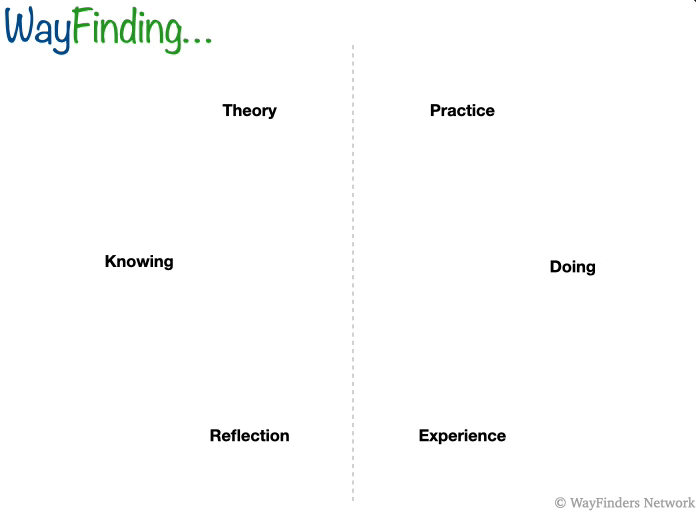Action Learning

This is the third post in a series on the core concepts underpinning the WayFinders Network & WayFinder Platform. These core concepts are…
-
WayFinder Philosophy (link)
-
Networks (link)
-
Action Learning (this post)
-
Stories & “working out loud” (still to come)
This post on Action Learning is a key one, as it is arguably the concept that glues everything together. As a result, over the last couple of days I’ve noticed procrastination setting in over the best way of communicating the ideas. Instead, I should be living the action learning approach itself of having a sense of the general direction I want to head with this post, start crunching the keyboard (acting), attending to and making sense of what emerges (learning) and responding to that (acting).
(hey, am I done…is that all that needs to be said regarding Action Learning? 🤔 If you feel not, read on, with no guarantees any greater clarity will emerge 😉)
Definitions
As I’ve done with previous posts, providing some existing definitions could be helpful. Let’s throw a few out there (but without claiming they are the authoritative ones)…
Action learning is an experiential learning method in which participants learn by doing and then reflecting on what they have done. (link)
The ethos of action learning is to ‘take an attitude of enquiry’ based on the principle that experiences generate knowledge. Action learning seeks to facilitate skill development based on integration of knowledge gained from experience and knowledge gained by formal learning, underlined by critical reflection (link)
Action Learning is a process that involves a small group working on real problems, taking action, and learning as individuals, as a team, and as an organization. It helps organizations develop creative, flexible and successful strategies to pressing problems. (link)
As I said, these are not necessarily authoritative definitions, and perhaps fail to capture the essence of “why” and “when” action learning is the appropriate approach. So let’s try to do that.
As laid out in the core concepts post, WayFinding is a philosophy and “way of being” for dealing with uncertainty. Uncertainty is arguably an inherent part of life, significantly heightened amidst the disruption of the global pandemic and the new paths that need to be explored as a consequence (“innovation”). How do we reduce uncertainty in a given situation? We need to both “act to learn” and “learn to act”. This ‘coupling’ potentially dissolves some historical divides and dualisms in western culture…

The above is coherent with past and present ideas in philosophy, psychology and biology. A few decades ago Psychologist James Gibson proposed that “we perceive to act, and we act to perceive”, whilst the fancy new concept on the block - Active Inference and the Free Energy Principle - suggests that we can reduce uncertainty (minimise free energy in their lingo) by acting in our environment rather than just being passive perceivers…
Active inference refers to the minimisation of surprise - or resolution of uncertainty - during the active sampling of an environment. (link)
Action Learning can play out over varying time frames, people and places (temporal and spatial scales). From smaller to larger scales it is exemplified by…
- Lionel Messi jinking and jiving with the ball at his feet as he seeks to destabilise and find a way past his opponent in a 1v1 on the edge of the box.
- A performance of ‘improv’ theatre, ("Often ‘improv’ is a conversation. It is certainly a mindset, as you accept the external data and respond. Your response and the reaction to it then become part of the external data" - Neil Mullarkey)
- A work team in an organisation navigating a shift from hierarchical to self-management (link)
- Entire neighborhoods exploring ‘systems of participation’ over multiple years (link)
(note: arguably these Action Learning “loops” of varying spatio-temporal scales are nested and even intertwined, but I’m going to steer clear of that rabbit hole for now 😬)
So, WayFinding requires an Action Learning approach, where we have a general sense of direction (top right corner in the animation below) and attempt to move in that direction through continual cycles of ‘acting to learn’ and ’learning to act’…

Extended time scales, like the last two of the four examples listed above, afford more time for “learning to act” and could involve reflection, group dialogue, deliberation, sense-making etc. However the intention is always to orient our next action(s) in the messy and uncertain “real world”. This is why we call it ’learning to act’, NOT ’learning to know’; ’learning to pass an exam’; ’learning to write a research report’; ’learning to explicate a theoretical framework’…historically the sorts of things we associate with learning due to the enculturating influence of much formal education.
Finally, it is critical that “learning to act” is informed by “practice-based evidence”, generated from our actions and experiences. A method for doing this is story capture and sharing, which can provide rich and contextualised accounts of how we acted and what emerged from those actions. Much more on stories, and how this method is supported by the WayFinder Platform, in the next post.